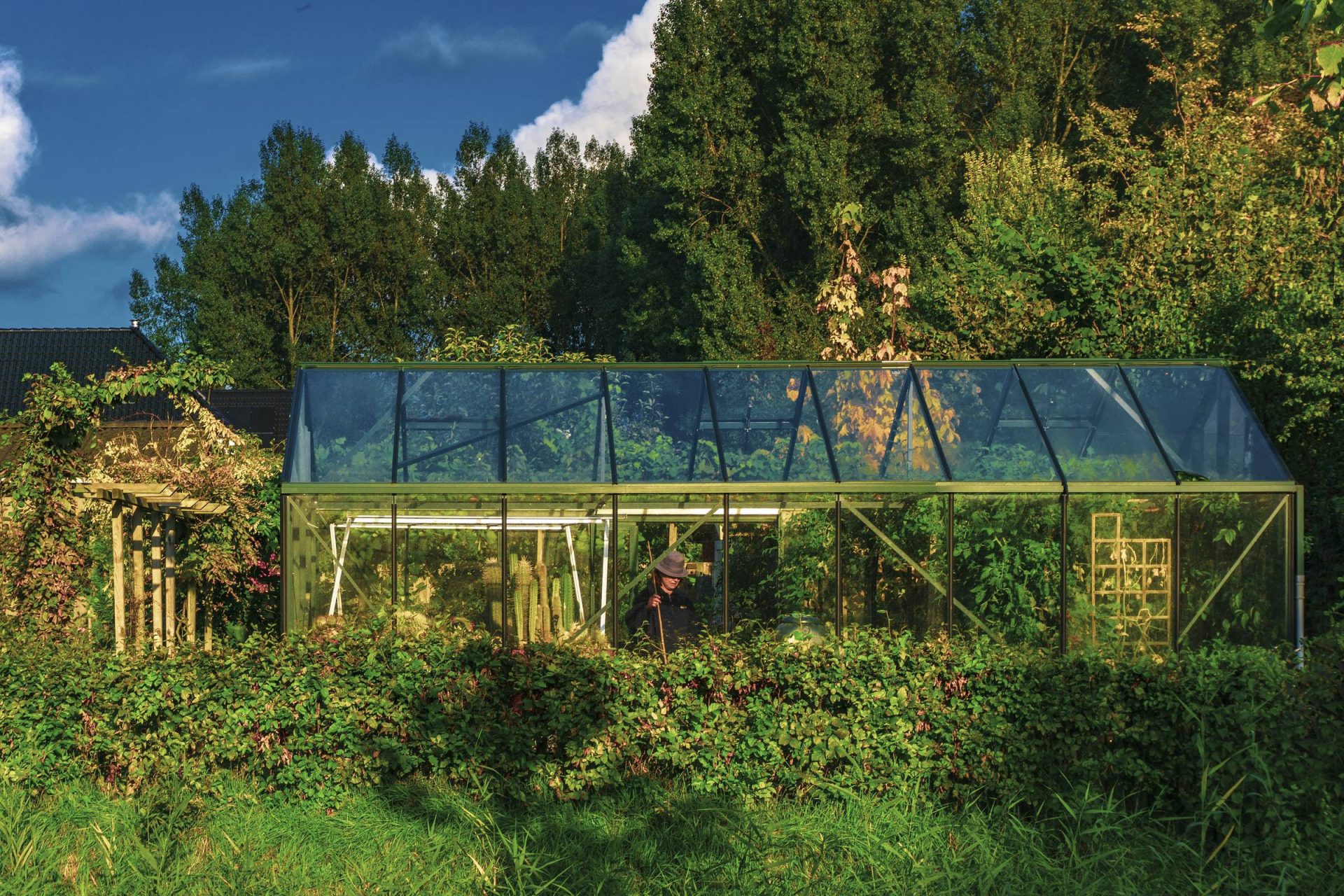Table of Content
Greenhouse business plan for starting your own business
If you are looking to start a new business, one that can be profitable always, without being impacted by any external factor, this business plan for green house is what you need. As long as there are humans on this planet, they’ll need to eat and that’s the reason this field can never go out of business.
This business will be even more profitable for ones who own their own land and don’t have to lease it. Making it the best business plan for landlord. Let’s now see how to write a business plan for a greenhouse so that you can enter this business and make money.
Executive Summary
2.1 The Business
Candyland Greenhouse will be a registered and licensed greenhouse farming company in Ohio, USA. This business will be used as an example of starting greenhouse business plan. The aim of this business will be to provide all greenhouse crops to the state.
2.2 Management of Greenhouse Business
Before you learn more about how to start a greenhouse business, you need to learn how the business will be managed. The greenhouse business start up will be owned and presided by John Candy. He will hire three managers for operations, liaison, and procurement to handle the day-to-day operations of the greenhouse.
The supreme authority in the business will reside with John Candy himself. Any matter of significant importance must be brought to his notice. This business plan and management structure of the farm is created by professional business plan writers and is designed to be applicable to any greenhouse business in any part of the world. One thing must be kept in mind that unlike a microbrewery business plan, this business will need a lot of starting capital.
2.3 Customers of Greenhouse Business
As greenhouses produce food, everyone with a beating heart is technically a customer. We will be providing our products to the following customers:
- Retail customers.
- Grocery stores.
- Restaurants.
- Supermarkets.
2.4 Business Target
The business target we have set for this venture are the following:
- Starting to generate a revenue of more than $201,161 by year 2.
- Expanding to two other states by year 5.
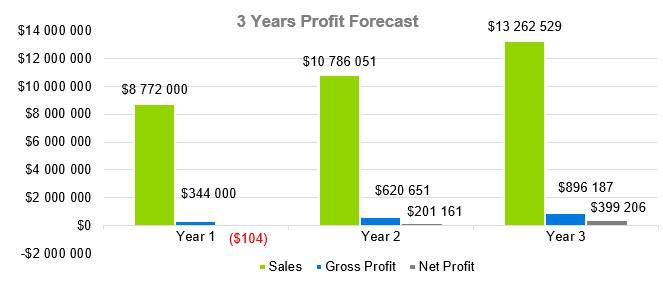
Company Summary
3.1 Company Owner
The owner of this vegetable greenhouse business plan, will be John Candy. John is an agriculture engineer and has been providing consultancy services for progressive farming for the last 10 years. He has immense interest in new farming techniques, and the capital needed to start the business.
3.2 Why the Greenhouse Farming Business is being started.
The reason John is starting this business is that there is a serious gap between the supply and demand of greenhouse crops in the area. People go through a lot of trouble just to get non-seasonal veggies and fruits and can only get them in frozen form, fresh ones are not available.
This sample greenhouse business plan aims to target this market gap and make a lot of money while we are at it. Let’s now explore more details of this greenhouse farming business plan doc. Before that, if you want to get into the food business here’s a seafood restaurant business plan.
3.3 How the Greenhouse Business will be started.
Step1: Planning
The first step of starting this business will be planning. We need to make a solid plan starting from where the farm will be located to the buyers, we’ll be supplying the product to. All the planning aspects of the business will be discussed in this greenhouse farming business plan.
Step2: Building a Brand
One of the main practical things to do, one which needs to be started even before the physical structure of the farm comes into existence is the brand building.
Step3: Establish Your Corporate Office
Jack decided to rent a building in Manhattan to establish his business office. He will procure the latest cleaning equipment and inventory to set his business. Just like a gourmet food store business plan, we need to make sure that we have a brand that people know before we actually start the business.
Step4: Going Online
As people tend to buy a lot of stuff online, we’ll be offering our products on our online store. For this, an e-commerce website and social media pages will be created.
Step5: Promote and Market
Lastly, we’ll promote our brand via all advertisement channels so that people know the name.
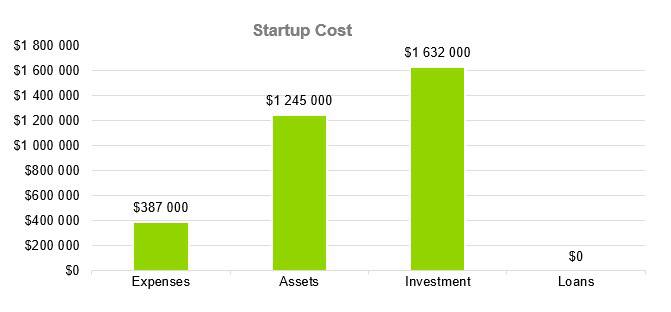
| Start-up Expenses | |
| Legal | $245,000 |
| Consultants | $0 |
| Insurance | $28,000 |
| Rent | $31,000 |
| Research and Development | $22,000 |
| Expensed Equipment | $57,000 |
| Signs | $4,000 |
| TOTAL START-UP EXPENSES | $387,000 |
| Start-up Assets | $344,000 |
| Cash Required | $355,000 |
| Start-up Inventory | $42,000 |
| Other Current Assets | $233,000 |
| Long-term Assets | $271,000 |
| TOTAL ASSETS | $1,245,000 |
| Total Requirements | $1,632,000 |
| START-UP FUNDING | |
| Start-up Expenses to Fund | $387,000 |
| Start-up Assets to Fund | $1,245,000 |
| TOTAL FUNDING REQUIRED | $1,632,000 |
| Assets | |
| Non-cash Assets from Start-up | $1,631,000 |
| Cash Requirements from Start-up | $385,000 |
| Additional Cash Raised | $53,000 |
| Cash Balance on Starting Date | $36,000 |
| TOTAL ASSETS | $2,105,000 |
| Liabilities and Capital | |
| Liabilities | $28,000 |
| Current Borrowing | $0 |
| Long-term Liabilities | $0 |
| Accounts Payable (Outstanding Bills) | $47,000 |
| Other Current Liabilities (interest-free) | $0 |
| TOTAL LIABILITIES | $75,000 |
| Capital | |
| Planned Investment | $1,632,000 |
| Investor 1 | $0 |
| Investor 2 | $0 |
| Other | $0 |
| Additional Investment Requirement | $0 |
| TOTAL PLANNED INVESTMENT | $1,632,000 |
| Loss at Start-up (Start-up Expenses) | $473,000 |
| TOTAL CAPITAL | $2,105,000 |
| TOTAL CAPITAL AND LIABILITIES | $2,180,000 |
| Total Funding | $1,632,000 |
Services
The next big thing that we need to discuss in this organic greenhouse business plan is the services we will be providing. This is necessary to complete this greenhouse business example. The thing that we need to be clear on before actually starting greenhouse business is that this is more of a products business than a services one. All the services provided by this business will be based on the products that we will provide to the customers.
The main services that we will provide after opening a greenhouse business will be the following:
- Organic Food Provision
We will be providing organic food delivery services to businesses as well as individual customers. As the trend of organic food is on the rise, this will help us make a lot of money.
- Non-Seasonal Veggies Provision
This is one of the most obvious services for the greenhouse. We will grow and supply veggies that are not in the season and this will be another of the main income streams for the business.
- Exotic Fruits
Another of the services of this greenhouse business plan example will be exotic fruits. We will grow and supply fresh exotic fruits, something that is not available on the market.
- Farm Outlet Shop
Last, but not the least, we will establish a farm outlet and provide all our product for sale there.
These are just the services we are providing as a starting point of our greenhouse business plan template and we will add more services later.
Let’s now see more aspects of this tomato greenhouse business plan pdf.
Marketing Analysis of Greenhouse Business
Note
Marketing analysis is the name given to the extensive research of the market you are about to enter. This organic greenhouse business plan covers this aspect too. This is very important for starting greenhouse business because any business started without proper research of the market fails miserably. Opening a greenhouse business is not a big deal but if you want to make it profitable, you need to know the market inside out.
One thing can be safely assumed in this greenhouse business plan example and that is; the greenhouse business is not going anywhere anytime soon. People no longer want to be bound to eating just the seasonal vegetables. If we can create a way of providing all vegetables all-year-long, sky is the limit for us. Just like a distillery business plan, this business has a very low chance of failure.
Business plan for investors
5.1 Market Trends
If we have a look at the size and growth rate of this industry, it is mind boggling. The greenhouse industry was worth $17 billion in 2019 in USA alone. It is expected to show a combined annual growth rate of a whopping 10%. This means that in just 5 years from now this industry will be worth over $50 billion dollar.
That is the kind of growth that you do not see everywhere. Now is the time to enter this industry and make money while we can. Like we said in the brewery business plan, such opportunities are rare, and you need to catch them if you can.
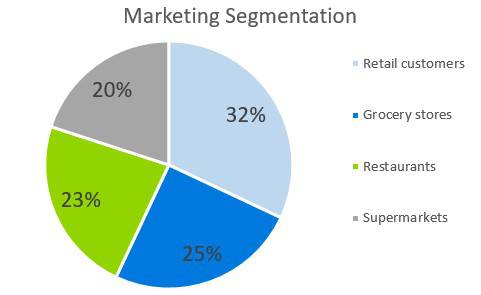
5.2 Marketing Segmentation
The market segmentation of the greenhouse farming business will be the following:
5.2.1 Retail customers
These will be the people who want to buy the products for their personal use. We will open a farm shop just outside the farm to cater the needs of these customers. The size of these sales will be small, but the large number of sales will make up for it.
5.2.2 Retailers
Grocery stores and retailers will also be one of the market segments that we will be targeting. These will be our regular customers. We will offer this market segment discounted rates to make them our permanent customers and to advertise our name through them.
5.2.3 Restaurants
Restaurants that offer non-seasonal vegetable and fruit dishes and need fresh products for that will also be our customers. We will give them discounts to make them our long-term customers.
5.2.4 Supermarkets
Supermarkets that have fruit and vegetable stalls and need to have fresh fruits and vegetables for sale will also make a major segment of our target market.
| Market Analysis | |||||||
| Potential Customers | Growth | Year 1 | Year 2 | Year 3 | Year 4 | Year 5 | CAGR |
| Retail customers | 32% | 37,000 | 38,000 | 40,000 | 42,000 | 44,000 | 10.00% |
| Grocery Stores | 25% | 25,000 | 26,000 | 27,000 | 28,000 | 30,000 | 10.00% |
| Restaurants | 23% | 20,000 | 21,000 | 22,000 | 24,000 | 25,000 | 10.00% |
| Supermarkets | 20% | 16,000 | 17,000 | 19,000 | 21,000 | 23,000 | 11.00% |
| Total | 100% | 98,000 | 102,000 | 108,000 | 115,000 | 122,000 | 10% |
5.3 Business Target
- To become the leading supplier of greenhouse products in the area.
- To expand to other states by the end of year 2.
- To experiment and improve the techniques of growing crops in a greenhouse.
- To be the leading greenhouse business in the USA by the end of year5.
5.4 Product Pricing
We will price our products a bit lower than the competitors to get permanent customers. Once we make a loyal customer base, we will then move on to competitive pricing.
Marketing Strategy
If you really want to know how to open a greenhouse, one of the most important things to have is a strong marketing strategy for the business. Your marketing strategy is what helps you get on top of the game and outperform the competition. Let’s see how to open a greenhouse business with a winning marketing strategy.
The marketing strategy we are adopting for this greenhouse business model is simple; make it known to everyone and offers products and services not given by any competitor.
6.1 Competitive Analysis
After an extensive research of the market, we’ve determined that Candyland Greenhouse will have the following competitive edges:
- No business is providing fresh non-seasonal fruits and vegetables in the area, and we will be the first one to do so.
- Exotic fruits being sold in the area are imported and are sold a week or so after being picked from the farms. We will provide fresh ones.
- Organic non-seasonal fruits and veggies are not available in the area and we will be the first company to provide these products.
6.2 Sales Strategy
- We will use multiple channels to advertise out products and services.
- We’ll arrange giveaways at the time of the launch to make it known to the potential customers that we provide quality products.
- We’ll provide a 25% discount on all cash orders for the first 2 months.
6.3 Sales Monthly
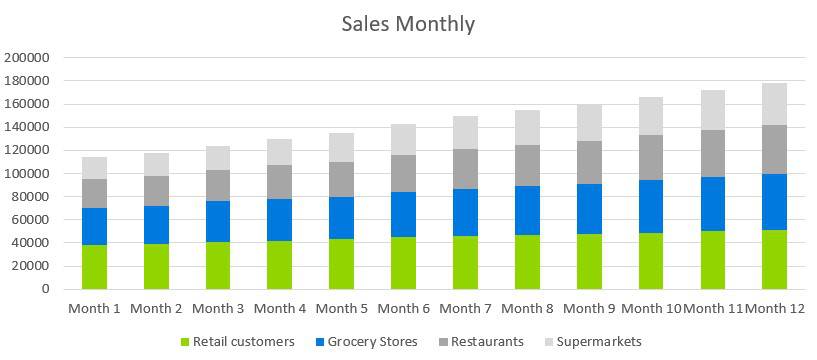
6.4 Sales Yearly
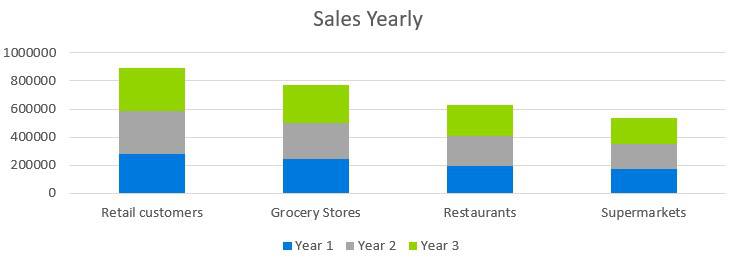
6.5 Sales Forecast
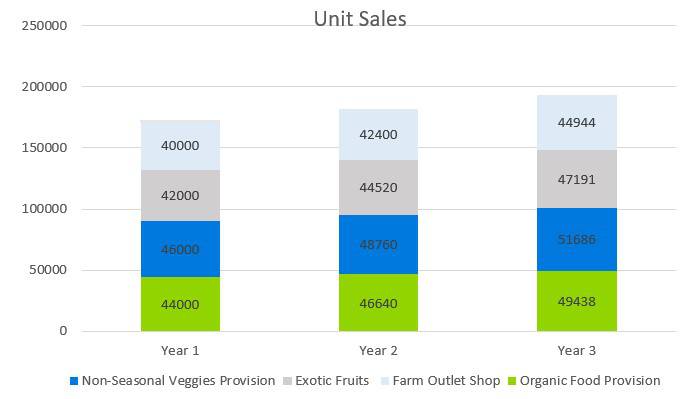
| Sales Forecast | |||
| Unit Sales | Year 1 | Year 2 | Year 3 |
| Organic Food Provision | 44,000 | 46,640 | 49,438 |
| Non-Seasonal Veggies Provision | 46,000 | 48,760 | 51,686 |
| Exotic Fruits | 42,000 | 44,520 | 47,191 |
| Farm Outlet Shop | 40,000 | 42,400 | 44,944 |
| TOTAL UNIT SALES | 172,000 | 182,320 | 193,259 |
| Unit Prices | Year 1 | Year 2 | Year 3 |
| Organic Food Provision | $45.00 | $52.20 | $60.55 |
| Non-Seasonal Veggies Provision | $52.00 | $60.32 | $69.97 |
| Exotic Fruits | $60.00 | $69.60 | $80.74 |
| Farm Outlet Shop | $47.00 | $54.52 | $63.24 |
| Sales | |||
| Organic Food Provision | $1,980,000.00 | $2,434,608.00 | $2,993,594.00 |
| Non-Seasonal Veggies Provision | $2,392,000.00 | $2,941,203.20 | $3,616,503.45 |
| Exotic Fruits | $2,520,000.00 | $3,098,592.00 | $3,810,028.72 |
| Farm Outlet Shop | $1,880,000.00 | $2,311,648.00 | $2,842,402.38 |
| TOTAL SALES | $8,772,000.00 | $10,786,051.20 | $13,262,528.56 |
| Direct Unit Costs | Year 1 | Year 2 | Year 3 |
| Organic Food Provision | $43.00 | $49.00 | $56.00 |
| Non-Seasonal Veggies Provision | $50.00 | $57.00 | $65.00 |
| Exotic Fruits | $58.00 | $66.00 | $76.00 |
| Farm Outlet Shop | $45.00 | $51.00 | $59.00 |
| Direct Cost of Sales | |||
| Organic Food Provision | $1,892,000.00 | $2,285,360.00 | $2,768,550.40 |
| Non-Seasonal Veggies Provision | $2,300,000.00 | $2,779,320.00 | $3,359,564.00 |
| Exotic Fruits | $2,436,000.00 | $2,938,320.00 | $3,586,531.20 |
| Farm Outlet Shop | $1,800,000.00 | $2,162,400.00 | $2,651,696.00 |
| Subtotal Direct Cost of Sales | $8,428,000.00 | $10,165,400.00 | $12,366,341.60 |
Personnel plan
The next important thing to mention in this business plan for greenhouse farming is the detail of the staff that will be needed to run the business. As agriculture is a labor-intensive business, we’ll have to hire quite a bit of staff for the farm to run smoothly. This is not a butcher shop business plan where you can make do with a couple of men.
7.1 Company Staff
- John Candy will be the CEO of the company.
- 3 Managers for operations, liaison, and procurement.
- 8 Farm workers.
- 1 Technician.
- 1 Accountants.
- 2 Shopkeepers for farm outlet
- 1 Software engineer for the online store and social media presence management.
- 3 Delivery drivers.
- 2 Security guards.
7.2 Average Salary of Employees
| Personnel Plan | |||
| Year 1 | Year 2 | Year 3 | |
| Operation Manager | $14,000 | $15,400 | $16,940 |
| Liaison Manager | $13,000 | $14,300 | $15,730 |
| Procurement Manager | $13,000 | $14,300 | $15,730 |
| Farm Workers | $65,000 | $71,500 | $78,650 |
| Technician | $8,000 | $8,800 | $9,680 |
| Accountant | $10,000 | $11,000 | $12,100 |
| Shopkeepers | $16,000 | $17,600 | $19,360 |
| Software Engineer | $9,000 | $9,900 | $10,890 |
| Delivery Drivers | $24,000 | $26,400 | $29,040 |
| Security Guards | $16,000 | $17,600 | $19,360 |
| Total Salaries | $188,000 | $206,800 | $227,480 |
Financial Plan
A strong financial plan is also one of the very important things required to complete a commercial greenhouse business plan. This part of the business plan elaborates the costs that will be incurred by the owner of the business in order to start it and run it until it starts making profit.
The expenses will include:
- Money needed to buy the land for the greenhouse.
- Price of constructing the greenhouse.
- Running expenses of the farm before it starts making profit.
- Salaries of the employees for the first 6 months.
- Prices of delivery vehicles.
- Cost of setting up the outlet.
8.1 Important Assumptions
| General Assumptions | |||
| Year 1 | Year 2 | Year 3 | |
| Plan Month | 1 | 2 | 3 |
| Current Interest Rate | 8.16% | 8.19% | 8.26% |
| Long-term Interest Rate | 8.39% | 8.48% | 8.52% |
| Tax Rate | 24.20% | 24.45% | 25.80% |
| Other | 0 | 0 | 0 |
8.2 Break-even Analysis
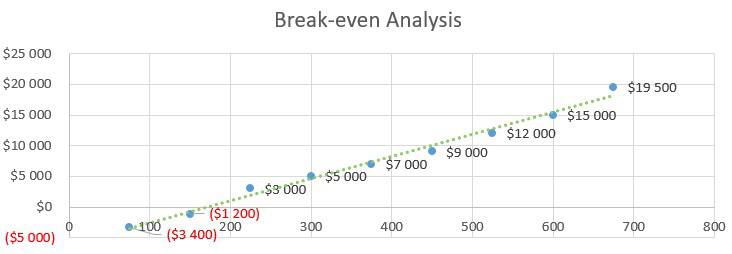
| Break-Even Analysis | |
| Monthly Units Break-even | 5341 |
| Monthly Revenue Break-even | $130,500 |
| Assumptions: | |
| Average Per-Unit Revenue | $235.00 |
| Average Per-Unit Variable Cost | $0.69 |
| Estimated Monthly Fixed Cost | $165,000 |
8.3 Projected Profit and Loss
| Pro Forma Profit And Loss | |||
| Year 1 | Year 2 | Year 3 | |
| Sales | $8,772,000 | $10,786,051 | $13,262,529 |
| Direct Cost of Sales | $8,428,000 | $10,165,400 | $12,366,342 |
| Other | $0 | $0 | $0 |
| TOTAL COST OF SALES | $8,428,000 | $10,165,400 | $12,366,342 |
| Gross Margin | $344,000 | $620,651 | $896,187 |
| Gross Margin % | 3.92% | 5.75% | 6.76% |
| Expenses | |||
| Payroll | $188,000 | $206,800 | $227,480 |
| Sales and Marketing and Other Expenses | $120,000 | $125,000 | $130,000 |
| Depreciation | $2,130 | $2,200 | $2,300 |
| Leased Equipment | $0 | $0 | $0 |
| Utilities | $2,900 | $3,000 | $3,100 |
| Insurance | $2,100 | $2,100 | $2,100 |
| Rent | $3,000 | $3,100 | $3,200 |
| Payroll Taxes | $26,000 | $27,000 | $29,000 |
| Other | $0 | $0 | $0 |
| Total Operating Expenses | $344,130 | $369,200 | $397,180 |
| Profit Before Interest and Taxes | ($130) | $251,451 | $499,007 |
| EBITDA | ($130) | $251,451 | $499,007 |
| Interest Expense | $0 | $0 | $0 |
| Taxes Incurred | ($26) | $50,290 | $99,801 |
| Net Profit | ($104) | $201,161 | $399,206 |
| Net Profit/Sales | 0.00% | 1.87% | 3.01% |
8.3.1 Profit Monthly

8.3.2 Profit Yearly
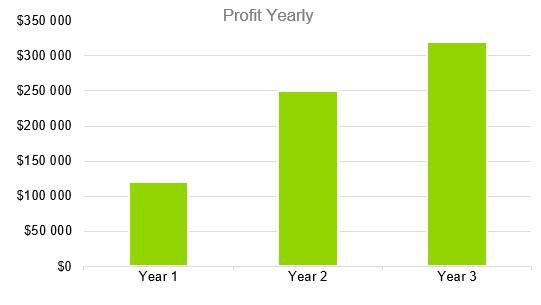
8.3.3 Gross Margin Monthly
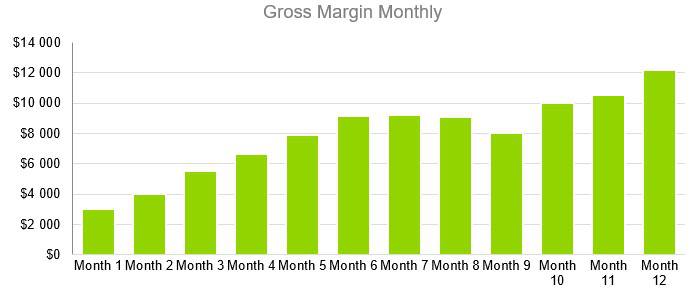
8.3.4 Gross Margin Yearly
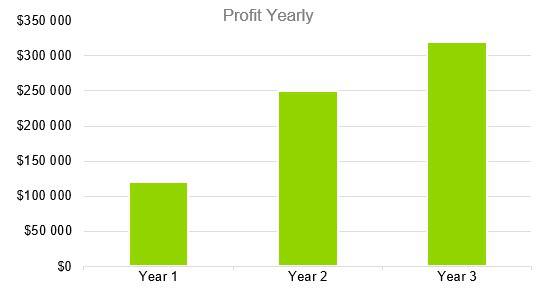
8.4 Projected Cash Flow
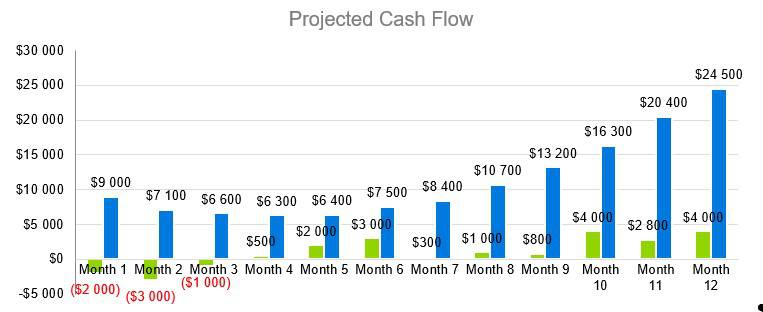
| Pro Forma Cash Flow | |||
| Cash Received | Year 1 | Year 2 | Year 3 |
| Cash from Operations | |||
| Cash Sales | $56,000 | $60,480 | $65,318 |
| Cash from Receivables | $21,000 | $22,680 | $24,494 |
| SUBTOTAL CASH FROM OPERATIONS | $77,000 | $83,930 | $90,644 |
| Additional Cash Received | |||
| Sales Tax, VAT, HST/GST Received | $0 | $0 | $0 |
| New Current Borrowing | $0 | $0 | $0 |
| New Other Liabilities (interest-free) | $0 | $0 | $0 |
| New Long-term Liabilities | $0 | $0 | $0 |
| Sales of Other Current Assets | $0 | $0 | $0 |
| Sales of Long-term Assets | $0 | $0 | $0 |
| New Investment Received | $0 | $0 | $0 |
| SUBTOTAL CASH RECEIVED | $77,000 | $84,000 | $91,000 |
| Expenditures | Year 1 | Year 2 | Year 3 |
| Expenditures from Operations | |||
| Cash Spending | $37,000 | $39,000 | $41,000 |
| Bill Payments | $19,000 | $24,000 | $27,000 |
| SUBTOTAL SPENT ON OPERATIONS | $56,000 | $63,000 | $68,000 |
| Additional Cash Spent | |||
| Sales Tax, VAT, HST/GST Paid Out | $0 | $0 | $0 |
| Principal Repayment of Current Borrowing | $0 | $0 | $0 |
| Other Liabilities Principal Repayment | $0 | $0 | $0 |
| Long-term Liabilities Principal Repayment | $0 | $0 | $0 |
| Purchase Other Current Assets | $0 | $0 | $0 |
| Purchase Long-term Assets | $0 | $0 | $0 |
| Dividends | $0 | $0 | $0 |
| SUBTOTAL CASH SPENT | $65,000 | $70,200 | $75,816 |
| Net Cash Flow | $20,000 | $20,000 | $22,000 |
| Cash Balance | $30,000 | $31,000 | $33,000 |
8.5 Projected Balance Sheet
| Pro Forma Balance Sheet | |||
| Assets | Year 1 | Year 2 | Year 3 |
| Current Assets | |||
| Cash | $271,000 | $303,520 | $333,872 |
| Accounts Receivable | $25,000 | $28,000 | $31,472 |
| Inventory | $4,400 | $4,928 | $4,900 |
| Other Current Assets | $1,000 | $1,000 | $1,000 |
| TOTAL CURRENT ASSETS | $278,000 | $311,360 | $349,969 |
| Long-term Assets | |||
| Long-term Assets | $10,000 | $10,000 | $10,000 |
| Accumulated Depreciation | $18,800 | $21,056 | $23,688 |
| TOTAL LONG-TERM ASSETS | $23,300 | $26,096 | $29,358 |
| TOTAL ASSETS | $290,000 | $324,800 | $365,400 |
| Liabilities and Capital | Year 4 | Year 5 | Year 6 |
| Current Liabilities | |||
| Accounts Payable | $19,000 | $21,280 | $23,919 |
| Current Borrowing | $0 | $0 | $0 |
| Other Current Liabilities | $0 | $0 | $0 |
| SUBTOTAL CURRENT LIABILITIES | $19,000 | $21,280 | $23,919 |
| Long-term Liabilities | $0 | $0 | $0 |
| TOTAL LIABILITIES | $17,000 | $19,040 | $21,401 |
| Paid-in Capital | $30,000 | $30,000 | $31,000 |
| Retained Earnings | $50,000 | $54,500 | $59,950 |
| Earnings | $191,000 | $208,190 | $229,009 |
| TOTAL CAPITAL | $285,000 | $310,650 | $341,715 |
| TOTAL LIABILITIES AND CAPITAL | $302,000 | $324,800 | $365,400 |
| Net Worth | $293,000 | $319,370 | $351,307 |
8.6 Business Ratios
| Ratio Analysis | ||||
| Year 1 | Year 2 | Year 3 | INDUSTRY PROFILE | |
| Sales Growth | 7.22% | 8.00% | 8.86% | 3.00% |
| Percent of Total Assets | ||||
| Accounts Receivable | 9.28% | 10.28% | 11.39% | 9.80% |
| Inventory | 5.46% | 6.05% | 6.70% | 9.90% |
| Other Current Assets | 2.18% | 2.42% | 2.68% | 2.40% |
| Total Current Assets | 150.09% | 152.00% | 152.00% | 158.00% |
| Long-term Assets | 11.60% | 11.60% | 11.64% | 12.00% |
| TOTAL ASSETS | 100.00% | 100.00% | 100.00% | 100.00% |
| Current Liabilities | 4.96% | 5.00% | 5.05% | 4.34% |
| Long-term Liabilities | 0.00% | 0.00% | 0.00% | 0.00% |
| Total Liabilities | 7.66% | 7.72% | 7.79% | 7.38% |
| NET WORTH | 100.50% | 101.30% | 102.24% | 110.00% |
| Percent of Sales | ||||
| Sales | 100.00% | 100.00% | 100.00% | 100.00% |
| Gross Margin | 95.55% | 98.13% | 100.88% | 99.00% |
| Selling, General & Administrative Expenses | 93.95% | 96.49% | 99.19% | 97.80% |
| Advertising Expenses | 1.51% | 1.55% | 1.59% | 1.40% |
| Profit Before Interest and Taxes | 41.70% | 42.83% | 44.03% | 33.90% |
| Main Ratios | ||||
| Current | 34 | 35 | 36 | 32 |
| Quick | 32 | 32.4 | 33.21 | 33 |
| Total Debt to Total Assets | 0.18% | 0.18% | 0.17% | 0.40% |
| Pre-tax Return on Net Worth | 74.08% | 74.70% | 75.00% | 75.00% |
| Pre-tax Return on Assets | 94.24% | 98.95% | 103.90% | 111.30% |
| Additional Ratios | Year 1 | Year 2 | Year 3 | |
| Net Profit Margin | 33.00% | 34.02% | 35.08% | N.A. |
| Return on Equity | 55.74% | 57.47% | 59.25% | N.A. |
| Activity Ratios | ||||
| Accounts Receivable Turnover | 7.7 | 7.8 | 7.8 | N.A. |
| Collection Days | 100 | 100 | 100 | N.A. |
| Inventory Turnover | 31 | 32.55 | 33 | N.A. |
| Accounts Payable Turnover | 15 | 16 | 16.3 | N.A. |
| Payment Days | 27 | 27 | 27 | N.A. |
| Total Asset Turnover | 2.5 | 2.5 | 2.6 | N.A. |
| Debt Ratios | ||||
| Debt to Net Worth | -0.04 | -0.03 | -0.04 | N.A. |
| Current Liab. to Liab. | 1 | 1 | 1 | N.A. |
| Liquidity Ratios | ||||
| Net Working Capital | $245,000 | $258,720 | $273,208 | N.A. |
| Interest Coverage | 0 | 0 | 0 | N.A. |
| Additional Ratios | ||||
| Assets to Sales | 0.86 | 0.87 | 0.87 | N.A. |
| Current Debt/Total Assets | 1% | 0% | 0% | N.A. |
| Acid Test | 29.1 | 29.12 | 29.16 | N.A. |
| Sales/Net Worth | 2.1 | 2.2 | 2.3 | N.A. |
| Dividend Payout | 0 | 0 | 0 | N.A. |
Download Greenhouse Business Plan Sample in pdf
OGSCapital’s team has assisted thousands of entrepreneurs with top-rate business plan development, consultancy and analysis. They’ve helped thousands of SME owners secure more than $1.5 billion in funding, and they can do the same for you.



